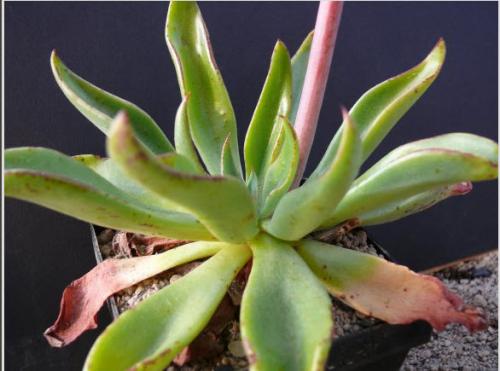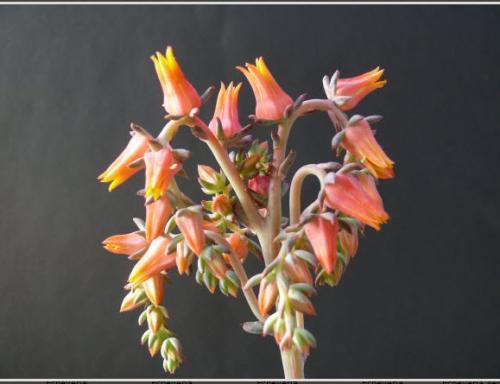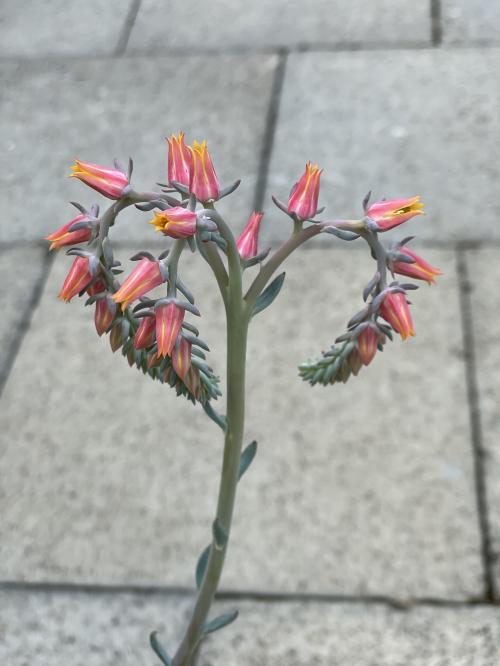SCHAFFNERI (Watson) Rose, 1903
Synonyms:
Cotyledon schaffneri Watson (1882) / Echeveria teretifolia var. schaffneri (Watson) Walther (1935)
Series Angulatae
Type : Schaffner 768, on sandy slopes of mountains around the city of San Luis Potosi, SLP, Mexico, 1876.
Etymology : Named for the collector of the plant.
Distribution : Mexico (Coahuila, Nuevo Leon, San Luis Potosí), growing “on sandy, gravelly outwashes at the foot of the mountains and flat land out on the dry plateau of west of the Sierra Madre Oriental"- see Note 1. below).
First Description as Cotyledon schaffneri by Watson in Proceedings of the American Academy of Arts and Sciences 17: 354. 1882 :
Acaulescent, the basal leaves narrowly lanceolate, narrowing from near the middle each way and acuminate, 3 or 4 inches long by 0.5 inch wide, somewhat purplish.
Cauline leaves rather numerous, linear, flattened, very acute, 1 to 1.5 inches long.
Flowering stem a foot high, bearing a 2-branched raceme (the branches 4 inches long and about 8 - 12-flowered), pedicels very short. (see Note 3. below)
Flowers : Sepals narrowly lanceolate, unequal, 2 to 5 lines long, corolla yellow and pink, 6 to 8 lines long, nearly twice longer than the carpels.
Cytology : n = 12.
A more accurate description of E. schaffneri compiled from several descriptions Reid Moran has made of Uhl's collections of this species (Uhl 2144, 2149, 2150 and 2151) :
Echeveria schaffneri (Watson) Rose, 1903
Caudex short, erect, 12 - 15 mm thick, with a cluster of thickened roots 3 – 8mm thick.
Rosette of ca 8 - 18 erect or ascending leaves.
Leaves green, oblanceolate, acute or acuminate, apiculate, 4 – 11 cm long, to 15 - 18 mm wide above and 10 mm at base, to 6 mm thick, ventrally channeled in the broadened upper part to a depth of 6 mm though essentially flat in the lower narrow « petiolar » part, dorsally rounded or somewhat keeled.
Floral stems ca 27 - 47 cm tall, 5 mm thick near base, somewhat purplish red below, bare in lower 5 – 10 cm, with ca 15 – 28 ascending leaves above ; leaves elliptic, acute, spurred, turgid but ventrally flattened, the lower to ca 35 mm long, to 10 mm wide and to 5 mm thick.
Inflorescence often bifurcate but sometimes also 3-branched, the branches cincinni up to 19 cm long, with up to 15 flowers and buds. Pedicel length very variable, form 0.5 – 9 mm and 1.5 – 3.5 mm thick.
Calyx disk 4 – 7 mm wide, the lobes ascending markedly unequal, triangular- to oblong-lanceolate, acute, the smallest 3 – 6 mm long, the largest up to 13 mm long, 2 – 5 mm wide.
Corolla 13 – 18 mm long, 7 - 8 mm wide near base, ca 5 - 6 mm wide near apex, 8 mm wide at tips, the tips then slightly spreading, near watermelon pink (1 K 9) / lighter pink, except for narrow yellow edges, (becoming darker red on withering) orange-yellow (near 9 K 8) within above, pentagonal, with channeled sides ; petals connate ca 3.5 / 4 mm, subtriquetrous with high narrowly rounded keel, 2.5 mm wide at base, 2 mm high, with narrow thin flange outturned at base, channeled ventrally and with deep nectar pit 3 mm long and 1.25 mm wide.
Filaments yellowish, ca 7 - 7.5 mm long from corolla base, the epipetalous adnate ca 4 mm, 0.6 mm wide, somewhat flattened, the antesepalous adnate ca 3 mm, ca 0.6 mm thick subulate ; anthers light yellow, 3.4 - 3 mm long. Nectar glands whitish, transversely lunate, 1.4 mm wide, 0.5 mm high. Gynoecium whitish, 8 - 9 mm high, 4 mm thick, the pistils erect, appressed, connate ca 2 mm, the ovaries tapering upward, 4 mm high, the styles tapering, 4 - 3 mm long, greenish. Ovules 0.4 mm long, 0.2 mm thick.
n = 12
Note :
1. According to Uhl (Haseltonia 6, 1998) E. schaffneri is distinctive in growing “on sandy, gravelly outwashes at the foot of the mountains and flat land out on the dry plateau of west of the Sierra Madre Oriental. The type locality is on sand hills near the city of San Luis Potosí. … Leaves are dark green and differ from those of E. strictiflora in being more or less canaliculate. They also lack the reddish margins seen in Mexican collections of that species and in E. walpoleana. In his key, Walther (1972) characterized E. schaffneri as having reddish leaf margins, but I am convinced this was because he misidentified some collections of E. walpoleana. For example, he cited localities for E. schaffneri on the wetter east side of the Sierra Madre Oriental in Tomasopo Canyon, S.L.P., and at Necaxa, Puebla, but plants that I have had from at or near both of these places were E. walpoleana, which does have reddish leaf margins.”
This means Walther's description of E. schaffneri in fact is a decription of E. walpoleana and therefore is unusable and accordingly also Kimnach's summary of it in the Illustrated Handbook of Succulent Plants, 2003. And the same applies to Pilbeam's text in The genus Echeveria, 2008, and to the photo by Paul Forster of a plant with red leaf margins, explicitly not correct for E. schaffneri, as well as for the localities listed, partly referring to E. walpoleana.
For more details see p. 211-213 in Revision of Walther's monograph Echeveria, 1972.
2. E. schaffneri sometimes is confused with E. walpoleana, however if its habitat conditions are accounted for, a confusion is much less likely.
3. While the First Descriptions of E. schaffneri and E. walpoleana indicate 2-branched inflorescences, both species can produce inflorescences with up to 4 branches.


Photos Gerhard Köhres

Photo Margrit Bischofberger